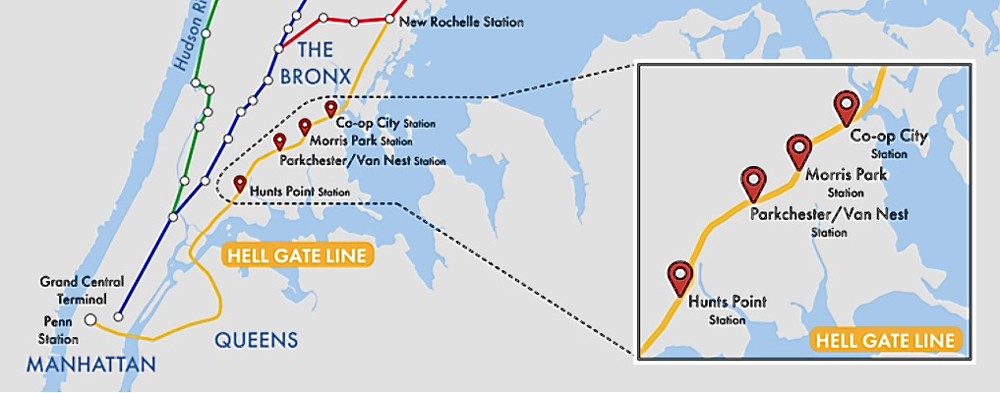
NEW YORK — Amtrak and New York’s Metropolitan Transportation Authority have reached agreement on funding two projects to aid rail travel in the New York City area.
The New York Times reports that, in a deal brokered by Sen. Chuck Schumer (D-N.Y.), Amtrak will use $500 million of the money it received from the recently signed $1.2 trillion infrastructure bill toward the $2.87 billion Penn Station Access project, which will use Amtrak’s route north of the city to allow Metro-North commuter trains to reach Penn Station [see “Plan to bring Metro-North service to Penn Station gets federal approval,” Trains News Wire, Sept. 29, 2021].
In return, the MTA will spend as much as $432 million on a $1.3 billion project to repair Amtrak’s East River tunnels, which are also used by Long Island Rail Road trains. Those tunnels were damaged by flooding during Hurricane Sandy in 2012.
“The East River Tunnels are the most important link in the commute of hundreds of thousands of Long Islanders,” Schumer told the Times, “and a problem in one tunnel — like we have seen in the past — creates a nightmarish domino effect for the entire LIRR system, and that’s not acceptable, and now it will be addressed.”














Charles and any others still interested in this thread, here’s the link to the Railway Age article I referred to in my post above:
https://www.railwayage.com/passenger/commuterregional/for-mta-amtrak-an-east-bronx-tale/?RAchannel=home
Great pic of this 1907 creation. However, the article does not contain a section regarding the structural deficiency of the bridge. Cannot explain why I so recall that it did. Or perhaps I read it somewhere else.
I cannot answer your questions Charles but I’ll instead offer another topic not mentioned in this piece. That of the aging and structurally deficient Pelham Bay Drawbridge. One of Amtrak’s initial conditions for MNR access was the replacement of PBD and that NYState pay 100% of the cost. A Railway Age article covered the deal former Gov. Cuomo struck for MNR access that kicked the PBD issue down the road, IIRC for at least a decade. That article included, in great detail, the issue of PBD’s structural issues. So the underpinnings of PSA are not just the East River Tunnels. I’m hugely in favor of PSA and the enhanced mobility it will bring to the people who have lived in a “transit desert” for generations. But what good will all the effort be if PBD fails not long after the service launches?
Mark – Thanks for the post. Seems the New Haven Railroad is the gift that keeps on giving! (Or keeps on taking ……) Even without those drawbridges the New Haven Railroad would have gone broke.
Going way back in history, to get from Boston to New York or Philadelphia, one boarded a ship because overland travel with all those rivers to cross was very difficult. Seems that in 300 years not much has changed.
With very few exceptions, river traffic under those numerous NEC drawbridges is pleasure boats, almost 100% recreation, almost zero percent commerce. How much do those cabin cruisers pay for drawbridge construction or operation, or delay to trains? That I know of, nothing.
Sounds like a good project that could benefit many riders. As I have posted before, Co-Op city has existed for about 50 to 55 years without decent transit. In contrast the big residential development on the former site of the Glenview Naval Air Station north of Chicago has had a Metra stop all along.
I have two questions about the details. (1) Projected travel time to Penn Station via Hell Gate Bridge compared to Grand Central. (2) How convenient will the Co-op City station stop be to the residents.
Reply from New Yorkers would be appreciated.
Would be interesting the cost as well since this is a commuter rail acting as a intercity rapid transit for these residents. Currently the LIRR has a city fare from Atlantic terminal in Brooklyn to Jamaica Queens for 5 bucks. I hope the metronorth will do something similar so that such a transit option is financially feasible for those in the surrounding community.
Mr. Simon, what you suggest has merit given that a “city fare” is in effect on the LIRR Atlantic Terminal Branch. FWIW, it has been suggested that ridership at those 4 East Bronx stations may not be only to NYP. It’s possible there may be a reverse commute market from the East Bronx to the NH Line stations in NY and CT. At least pre-Covid, MNR operated on the Harlem Line a number of trains GCT-Southeast during the AM peak that stopped at in-city stations like Tremont and Fordham Road. There were even two trains that operated non-stop 125th Street-White Plains. The latter operated back to GCT in the evening peak.